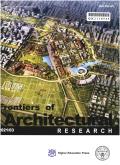景物框架对中国古典园林视觉深度感知的影响——以留园绿隐亭为例
IF 3.6
1区 艺术学
0 ARCHITECTURE
引用次数: 0
摘要
视觉深度(距离)感知是环境认知的一个基本方面,它使人们能够判断周围环境的空间尺度。然而,估计中国古典园林的深度是具有挑战性的,特别是从静态的角度来构建风景。以前的研究已经研究了景物框架的内部组成部分是如何影响深度感知的。然而,框架及其周边信息作为环境背景的作用在很大程度上被忽视了。本研究探讨了视点的深度感知如何受到观看位置位移、帧几何形状和环境背景的影响。作者在洞穴虚拟现实环境中创造了9种刺激材料(3个图像处理× 3个位置)。71名参与者被要求使用幅度估计和调整方法来评估深度感知。使用眼动仪(SensoMotoric Instruments (SMI)眼动追踪眼镜,120 Hz)记录他们的眼动行为。结果表明,在视点内部位移较小的情况下,被试仍能感知不同视点之间的空间深度差异;框架形状对深度知觉和凝视行为无显著影响;框架的周边视觉信息显著增强了深度感知。此外,环境背景的形式,特别是风景窗的位置,强烈地引导了参与者的目光。这些发现表明,环境视觉信息显著影响环境体验,这是景观设计师应该考虑的。本文章由计算机程序翻译,如有差异,请以英文原文为准。
Effects of scenery frame on visual depth perception in classical Chinese gardens: A case study of the Lvyin Pavilion in Lingering Garden
Visual depth (distance) perception is a fundamental aspect of environmental cognition, as it allows people to judge the spatial scale of their surroundings. However, estimating the depth of classical Chinese gardens is challenging, especially from static viewpoints that frame the scenery. Previous studies have examined how the internal components of the scenery frame affect depth perception. Still, the role of the frame and its peripheral information as environmental background have been largely overlooked. This study investigates how depth perception at viewpoints is influenced by viewing position displacement, frame geometry, and environmental context. The authors created nine stimulus materials in a cave virtual reality environment (three image treatments × three positions). Seventy-one participants were asked to evaluate depth perception using the magnitude estimation and adjustment methods. Their eye movement behavior was also recorded using an eye-movement instrument (SensoMotoric Instruments (SMI) eye-tracking glasses, 120 Hz). The results showed that participants could perceive spatial depth differences between viewing positions even when the internal viewpoint displacement was small; frame shape did not significantly affect depth perception and gaze behavior; and peripheral visual information of the frame enhanced depth perception significantly. Moreover, the form of the environmental background, especially the position of the scenery window, strongly guided the participants’ gaze. These findings suggest that ambient visual information significantly impacts environmental experience, which landscape designers should consider.
求助全文
通过发布文献求助,成功后即可免费获取论文全文。
去求助
来源期刊

Frontiers of Architectural Research
ARCHITECTURE-
CiteScore
6.20
自引率
2.90%
发文量
430
审稿时长
30 weeks
期刊介绍:
Frontiers of Architectural Research is an international journal that publishes original research papers, review articles, and case studies to promote rapid communication and exchange among scholars, architects, and engineers. This journal introduces and reviews significant and pioneering achievements in the field of architecture research. Subject areas include the primary branches of architecture, such as architectural design and theory, architectural science and technology, urban planning, landscaping architecture, existing building renovation, and architectural heritage conservation. The journal encourages studies based on a rigorous scientific approach and state-of-the-art technology. All published papers reflect original research works and basic theories, models, computing, and design in architecture. High-quality papers addressing the social aspects of architecture are also welcome. This journal is strictly peer-reviewed and accepts only original manuscripts submitted in English.
 求助内容:
求助内容: 应助结果提醒方式:
应助结果提醒方式:


